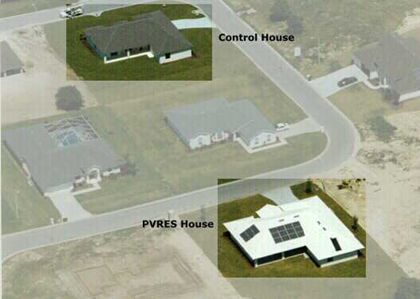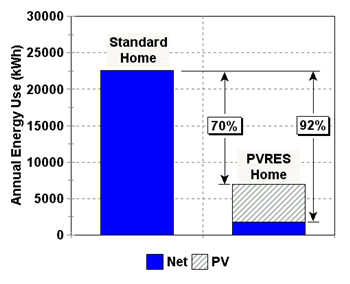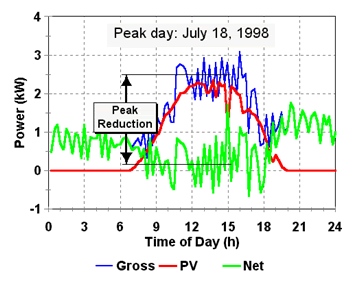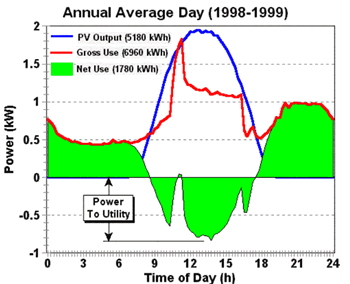
![]()
Examining the Limits of Building Energy Efficiency Through Side-by-Side Testing
In 1998 the Florida Solar Energy Center began its Zero Energy Homes research program in collaboration with the City of Lakeland municipal utility and builder Rick Strawbridge. Two homes, one the builder's standard model (the Control) and the other a super-energy-efficient photovoltaic residence (PVRES), were constructed and tested on a side-by-side basis for more than a year. The goal was to determine the extent to which contemporary energy efficiency technologies can reduce the demand for electricity in Florida homes. The measured results from this project were very encouraging and have since formed the basis for a national Zero Energy Homes program.
More information about the Zero Energy Home in Lakeland, Florida:
Below is an aerial photograph showing the two homes used in the Lakeland Zero Energy Homes project. As the photo indicates, the homes are identical in floor plan and orientations. However, they differ greatly in energy-efficiency with the Control Home being the builder's "standard" model that meets Florida's relativley stringent energy code and the PVRES home including the most energy-efficient provisions the FSEC project team could devise.

In one year, the PVRES home used 6960 kWh of electricity and had a PV system production of 5180 kWh. For the same year, the Control used 22,600 kWh. This gives a yearly energy savings due to the differences in the energy efficiency of the two homes of 70%. Putting the PV system production into the numbers shows that the PVRES house's net energy use (electricity from the utility) for the entire year was only 1780 kWh. Note in Figure 1 below that comparing the PVRES house energy, including the energy it produced, against the standard house shows that the PVRES house had a 92% utility energy savings compared to the standard house.
 |
| Figure 1. Bar chart of annual energy use in standard home and PVRES home showing 92% reduction in net annual energy use by PVRES home. |
|---|
Perhaps even more important than annual energy use is the fact that during periods of peak electric demand, the PVRES home, due to the PV system, placed nearly zero net demand on the utility system! This fact is clearly shown below in Figure 2, which plots the July 18, 1998, peak day energy demand, PV power production and net utility power data for the PVRES home. Note the green line, which shows the net utility energy used by the PVRES house on the hottest day in recorded history for Lakeland!
 |
| Figure 2. Plot of peak day energy flows in PVRES home showing how PV power production reduces net energy demand during the day to near zero. |
|---|
A similar energy use and production plot for the annual average day shows even more impressive results for the PVRES home with net power flowing from the home to the utility for almost the entire period of daylight. Figure 3 below illustrates this fact, showing the annual average PV output and the utility peak load reduction (shaded). Again, note the green line showing power going from the home to the utility during daylight hours.
 |
| Figure 3. Plot showing measured annual average PV production, total home energy use and net home energy use for PVRES home during 1998-1999 monitoring period. |
|---|
